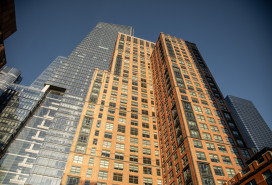When it rains in NYC, don’t wade through flooded streets (it’s really gross)

A view of a flooded intersection at Fourth Avenue and Carroll Street in Park Slope in 2008. The same intersection flooded during Monday's storm.
Close to two inches of rain fell on New York City during Monday’s storms, causing some streets to turn into rivers and deluging some buildings. However, flooding is not just a nuisance to homeowners who have to muck out basements, it can be dangerous to your health.
Amateur video captured scenes of the rushing water, including a pedestrian attempting to cross a flooded Williamsburg street.
Many of the intersections that flooded in NYC this week are low-lying areas that experience chronic problems during storms. As familiar as these events are, it is critical not to come into contact with floodwater.
Why you should steer clear of floodwater
“When there is heavy rain, storm runoff floods the sewer system and mixes with wastewater from commercial and residential buildings. The resulting ‘combined sewage,’ is a cocktail of rain, trash, and toilet water that rushes from storm drains,” said Olivia Jovine, an urban planner at Localize.city, a home search platform that tracks data points across the city.
“When the system overflows, it's not uncommon for this combined sewage to back up into the city's streets. In extreme cases, as we saw in this most recent storm, it is advisable to not come into contact with the water,” says Jovine, who wrote “Disaster Preparedness NYC". The book includes advice, checklists, and how to create “go bags” when you seek shelter outside your home.
Jovine also recommends avoiding the beach for a few days after a storm because of contamination from storm runoff.
Similarly, the city’s emergency instructions recommend not coming into contact with floodwater, as it may be contaminated by oil, gasoline, or raw sewage.
“Avoid walking and driving through flooded areas. As few as six inches of moving water can knock a person over. Six inches of water will reach the bottom of most passenger cars, causing loss of control and possible stalling. One or two feet of water can carry away a vehicle,” according to the city’s website.
Where it floods
Here are the top 20 neighborhoods with the highest number of street flooding complaints per square mile:
Marble Hill, Manhattan: 143
Midland Beach, Staten Island: 56.1
Stapleton, Staten Island: 44.3
Arrochar, Staten Island: 43
Midtown South, Manhattan: 40.3
Chelsea, Manhattan: 38.2
Rosedale, Queens: 34.4
Coney Island, Brooklyn: 33.7
Far Rockaway, Queens: 33.6
Borough Park, Brooklyn: 30.4
Eltingville, Staten Island: 28.4
Upper West Side, Manhattan: 27.4
Oakwood Heights, Staten Island: 24.8
Gowanus, Brooklyn: 23.6
Laurelton, Queens: 23.1
New Springville, Staten Island: 22.8
Flatbush, Brooklyn: 22.5
St. Albans, Queens: 22.3
Dongan Hills, Staten Island: 21.3
Pelham Gardens, Bronx: 21.2
Localize.city analyzed 3,141 complaints to 311 about street flooding from Oct. 1, 2017 to Sept. 30, 2018. The 12-month period analyzed was one of the rainiest years in NYC history, and five of the top 10 wettest years in our city’s history have been since 2000.
You can use Localize.city to check if an address that’s on the market is in a flood-prone area and if there have been higher-than-average numbers of 311 calls about sewer issues like overflowing drains and roadway flooding within half a mile.
You Might Also Like





























